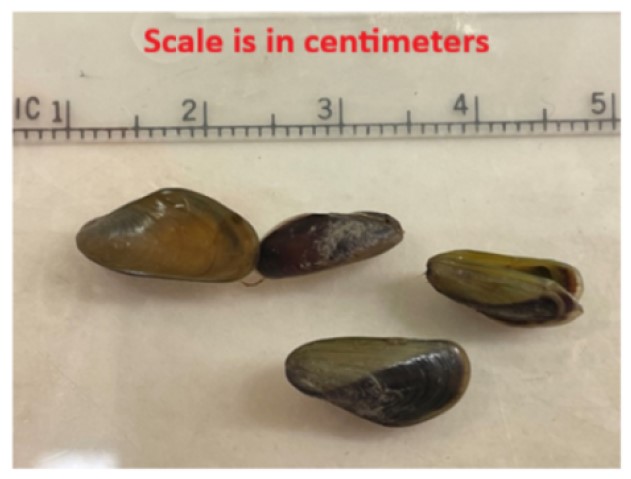Overview
 Golden Mussel shells collected in October 2024 at a water quality station at Rough and Ready Island near Stockton in San Joaquin County, California, USA. Photo: Elizabeth Wells, Ph. D. (DWR).
Golden Mussel shells collected in October 2024 at a water quality station at Rough and Ready Island near Stockton in San Joaquin County, California, USA. Photo: Elizabeth Wells, Ph. D. (DWR).
- The first North American detection of golden mussel (Limnoperna fortunei) was in October 2024. Although this mussel is similar in appearance and impacts to quagga and zebra mussels, it can establish in waters with wider temperature and salinity ranges.
- Environmental impacts include loss of native and game fish through competition for the same food sources and as a contributor to harmful, fish killing algal blooms.
- Recreational impacts of this mussel include waterbody closures, mandatory inspections, increased launch and/or entry fees, and reduced numbers of fish and shellfish for consumption.
- Economic impacts range include costly repairs and maintenance (boats, water infrastructure, hydroelectric facilities), reduced water flow affecting food production, water delivery to homes, and flood control.
- For more information, review our Golden Mussel Fact Sheet (PDF).
Mussel Detections
This map is updated as new sightings are confirmed.
Golden Mussel Survey Results in California map
If you observe this species, take clear, close-up photos using some suitable object to show scale (size), and immediately report online.
Protect the Waters You Like to Visit
The most common way that invasive mussels are unintentionally moved between waterbodies is by hitchhiking on watercraft and equipment. Keep the waters you enjoy safe and always do the following:
Outreach and Education Materials
- Invasive mussels rack card (printed)
- Clean, Drain, Dry poster (electronic file)
Request materials by emailing invasives@wildlife.ca.gov for an initial supply. CDFW will provide an electronic file for reproducing additional copies.
Recreational Waterbody Users
Press Releases
CDFW Invasive Species Program
P.O. Box 944209, Sacramento CA 94244-2090
Invasives@wildlife.ca.gov